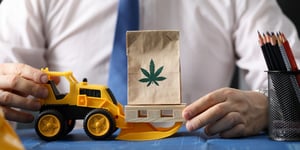 We often focus on minimizing Workers’ Compensation Insurance costs in potentially dangerous workplaces such as restaurants and construction sites: however, office spaces are not immune to workplace injuries.
We often focus on minimizing Workers’ Compensation Insurance costs in potentially dangerous workplaces such as restaurants and construction sites: however, office spaces are not immune to workplace injuries.
One of the most significant work-related injuries in an office are musculoskeletal disorders (MSDs). According to OSHA, “Work-related musculoskeletal disorders are the most widespread occupational health hazard facing our Nation today.” Every year, almost two million workers suffer from work-related MSDs, and approximately 600,000 of those workers lose time from work due to the MSD.
OSHA estimates the direct cost of MSDs to be between $15 and $20 billion every year, with total yearly costs in the $45 to $54 billion range. Plus, $1 out of every $3 spent on WC is a result of insufficient ergonomic protection, which can help avoid MSDs.
What Are Musculoskeletal Disorders?
The Bureau of Labor Statistics (BLS) of the Department of Labor describes MSDs as “musculoskeletal system and connective tissue diseases and disorders when the event or exposure leading to the case is bodily reaction (e.g., bending, climbing, crawling, reaching, twisting), overexertion, or repetitive motion.” MSDs affect joints, bones, muscles, the spine, etc. Examples of MSDs include carpal tunnel syndrome, tendonitis, degenerative disc disease, and tension neck syndrome.
The Centers for Disease Control and Prevention describes work-related MSDs as conditions in which “the work environment and performance of work contribute significantly to the condition; and/or the condition is made worse or persists longer due to work conditions.”
What is Workplace Ergonomics?
Workplace ergonomics - the science of fitting a job to a person so that they can work safely, without injury or pain - can help prevent MSDs, thereby reducing workplace injury and reducing Workers’ Comp and other expenses. A bonus is that it can actually improve a worker’s productivity.
Often, a few simple adjustments can make a huge difference, and it doesn’t have to cost a lot.
Ergonomics in the Office
Occupational Health & Safety reports that workers spend an average of 1,700 hours per year in front of a computer screen. That’s more than 70 days every year sitting at a desk. Sitting in the same position for long periods of time can cause pain and injury and lead to MSDs. Many office workers don’t even realize that they are sitting in awkward postures that can affect their health and safety.
Here are some of the most common ergonomic problems in an office:
- Monitors are too low, which forces flexion of the cervical spine.
- Armrests are not used properly or not at all, which can cause tensions in the neck, shoulders, and trapezius muscles.
- The mouse is not aligned with the shoulder, which can cause pain in the neck, wrist, and upper limbs.
- Workers use phones without a headset, which can cause pain in the shoulder and spine.
Here are some tips to improve office ergonomics:
- An office chair should allow for height adjustment so that the worker can sit with his or her knees at a 90-degree angle. It should also have adequate lumbar support and armrests, so elbows are at a 90-degree angle.
- The desk and chair should allow enough space for the user to cross their legs. Users should be able to rest their feet flat on the floor, so use a footrest if needed.
- Pad the edges of the desk if there are hard edges.
- A monitor should be placed, so the top is at or just below eye level and is an arm’s length away. The brightest light source should be to the side to avoid glare.
- The mouse should be directly in line with the shoulder, so the wrist remains straight.
- The height of the keyboard should allow the user to keep their wrists straight while typing.
- A phone should be held in one hand, or the user should use a headset.
MyAbilities offers a tool called Rapid Office Strain Assessment (ROSA), which is a self-guided self-assessment that shows workers how to adjust their workstation to prevent discomfort and injury.
Want to Save Even More on Workers’ Compensation?
Creating safe workplaces to avoid injuries is the best way to reduce WC costs. Another way to save on all commercial insurance costs is to work with one of the independent agents at American Insuring Group who specialize in Workers’ Compensation Insurance. Give us a call today at (800) 947-1270 or (610) 775-3848 or connect with us online to see how we can help you save on your Workers’ Compensation and other insurance costs.



 More than four years after Governor Tom Wolf signed the Pennsylvania Medical Marijuana Act into law, the implications of the law on construction site safety and
More than four years after Governor Tom Wolf signed the Pennsylvania Medical Marijuana Act into law, the implications of the law on construction site safety and  Every business in Pennsylvania with one or more employees is required to provide
Every business in Pennsylvania with one or more employees is required to provide  In the US, opioids are costing businesses
In the US, opioids are costing businesses  Third-party food delivery got a serious boost when Pennsylvania Governor Tom Wolf ordered all restaurants and bars to close their dine-in facilities to help stop the spread of COVID-19, while still permitting carry-out, delivery, and drive-through food and beverage service. Many restaurants began offering food delivery through apps such as Grubhub and UberEats.
Third-party food delivery got a serious boost when Pennsylvania Governor Tom Wolf ordered all restaurants and bars to close their dine-in facilities to help stop the spread of COVID-19, while still permitting carry-out, delivery, and drive-through food and beverage service. Many restaurants began offering food delivery through apps such as Grubhub and UberEats.  As specialists in
As specialists in  Michael E. Gerber wrote a book called The E-Myth Revisited: Why Most Small Businesses Don’t Work and What to do About it. In the book, Gerber introduces us to Sarah, a young woman who starts a bakery business to sell the pies that she loves to bake. Sarah is struggling. She’s working twelve hours a day and becoming frustrated and completely burnt out.
Michael E. Gerber wrote a book called The E-Myth Revisited: Why Most Small Businesses Don’t Work and What to do About it. In the book, Gerber introduces us to Sarah, a young woman who starts a bakery business to sell the pies that she loves to bake. Sarah is struggling. She’s working twelve hours a day and becoming frustrated and completely burnt out. If you want to lower
If you want to lower  More and more employers are moving away from the traditional guaranteed
More and more employers are moving away from the traditional guaranteed  Contractor Insurance is required to protect your assets and your business, whether you’re a one-person independent contractor or the owner of a construction company.
Contractor Insurance is required to protect your assets and your business, whether you’re a one-person independent contractor or the owner of a construction company.



